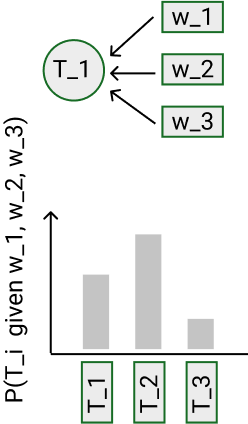Generative and discriminative models (ENG)
First attempt to summarize very broad topic of generative and discriminative models. I will be glad for every suggestion or discussion over this topic. I am sorry for math formulas but I wasn’t able to make it fully work yet. I will be trying to improve it over time.
Generative models:
- Estimates the joint probability distribution of data P(X, Y) between the observed data X and corresponding labels Y
- Provides a way to sample X, Y pairs
- To impute missing data, compress your dataset or generate unseen data.
\[ argmax_yP(Y=y|X=x)= argmax_y(\frac{P(Y=y,X=x)}{P(X=x)}) \] since P(X=x) is constant in argmax over y function so: \[ argmax_yP(Y=y,X=x) \]
Conditional Independence:
-
If we can say that P(X Y,Z) = P(X Z) then X is conditionally independent of Y given Z
\[ P(X|Y) = P(X1,X2|Y) \]
= general property of probabilities
= \[ P(X1|X2,Y)P(X2|Y) \]
= conditional independence assumption
= \[ P(X1|Y)P(X2|Y) \]
Method to estimate parameters:
- MLE is a special case of MAP, where the prior is uniform
- MLE - param = \[ argmax_p P(data|p) = argmax_p SUM(log(P(data|p))) \]
- MAP - param = \[ argmax_p P(data|p)*P(p) = argmax_p SUM(log(P(data|p)*P(p))) \]
- MLE vs MAP
Naive Bayes
- Generative model (joint probability P(Y,X)) * The basic idea is, first, to establish the probability density model of the sample, and then use the model for inference prediction * I have to care about a distribution of the Y and also the X
- Need to assume that features are independent
-
P(spam|”win” and “buy”) = P(spam win) * P(spam buy)
-
- Train time: O(log n)
* Discrete variant
* Maximum likehood estimates - count occurences (can be smoothed - Laplace smoothing)
* Maximum a posteriori estimation - if we assume a Dirichlet prior distribution then it is like Laplace smoothing
- Continuos
- Usually assuming Gaussian distribution of features
- Estimating Mean and Standart deviation
- Section 2.4.
- Continuos
Discriminative models:
- P(tags|data)
Logistic regression
-
Dicriminitive model (conditional probability **P(Y X)**) - The basic idea is to establish the discriminant function with finite samples, and directly study the prediction model without considering the generative model of samples.
- To don’t need a distribution of X
- Sigmoid function on the output of the model -> treshold determine 0/1 (in binomial case)
- Can be shown that the decision boundary is: Assign “Y=0” given “data” if 0 < w_0 + SUM(w_i* X_i)
- Section 3
- Try to find a relationship between output and input (via features)
- Train time: O(n)
- Gradient descent with respect to param vector W (with regularization)
- Need generally more data than Naive Bayes
- Naive Bayes can be derived from Logistic expression Section 3.1


HMM
- Generative model (joint probability P(states,data))
- Any observation sequence may be generated.
- Also concern distribution over data
- Get prediction with Viterbi algorithm
- Create directed graph
- Each state s_i depends only on state s_i-1 (Markov property)
- Each observation o_i depends only on current state s_i
- Propability distribution:
- Initial - Probability of a state at the beginning
- Transition - Probability of a transition from state A to state B
- Observation - Probability of emision a visible output from state
- Easier to estimate than CRF
- Assume conditionally independence over data (X_i does’t corelate with X_i+1)

CRF
- Dicriminitive model (conditional probability P(states|data))
- No assumptions about P(data)
- Versions:
- linear CRF (only previous item in input sequence - similar to Markov assumption)
- general CRF (you can use each item in input sequence)
- Need to manually specify feature/potential function
- can be indicator of some feature (fire up when some feature occur) - assign weights
- Get prediction with Viterbi algorithm
- Create undirected graph
- Basic principle is multiplication of feature functions with learning weights
- Logistic regression is very simply CRF (only one feature function)


Resources:
Written on July 30, 2018